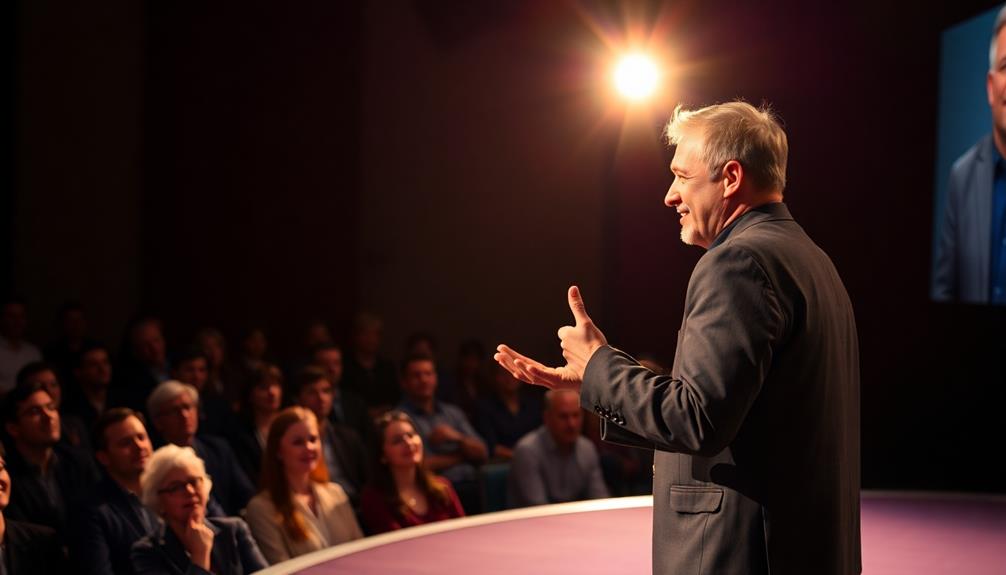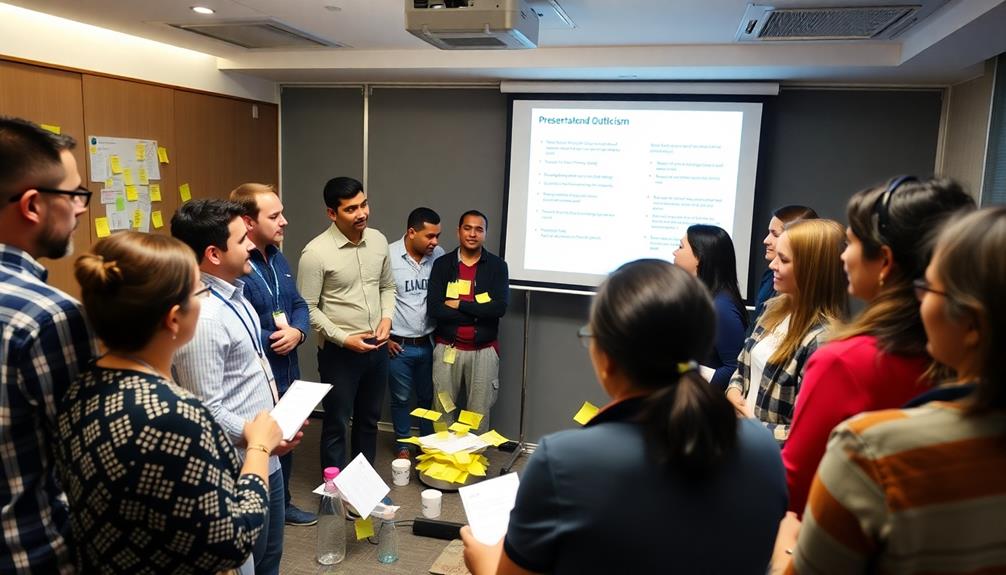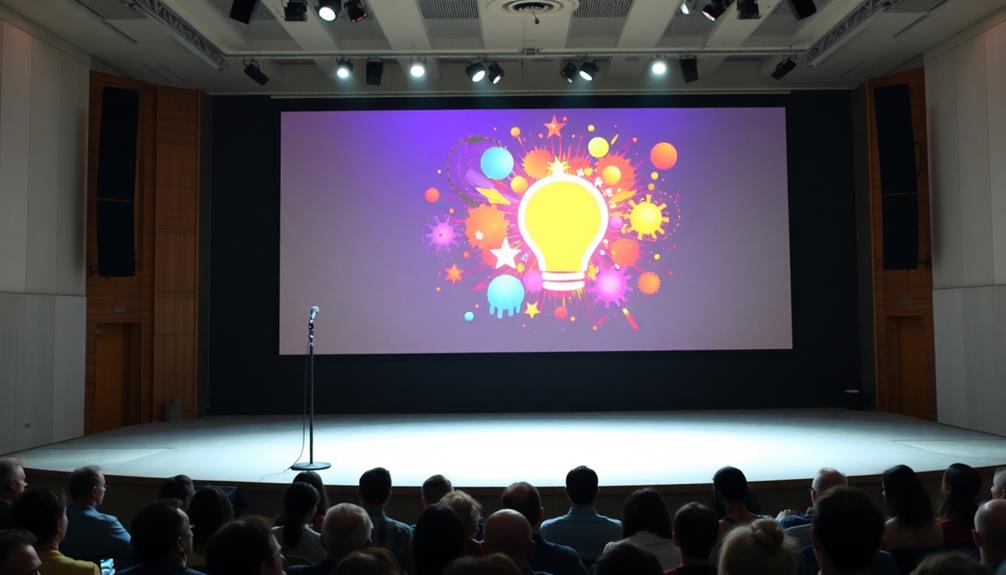To turn your personal story into a TED-style presentation, start by identifying your core message—a single, impactful sentence that captures your unique perspective. Structure your narrative with a clear beginning, middle, and end, and use emotional anecdotes to create connections with your audience. Make sure to include a strong call to action that inspires reflection or action. Enhance your message with effective visual aids that are simple but powerful. Finally, practice thoroughly, focusing on delivery and engagement. These steps will set the stage for a memorable presentation, and there's much more to discover about refining your approach.
Key Takeaways
- Distill your personal story into a memorable core message that addresses a problem, offers a unique perspective, and highlights impact.
- Structure your narrative with a clear beginning, middle, and end, using a problem-solution framework to guide the audience.
- Weave personal anecdotes to create emotional connections, emphasizing vulnerability and universal themes like resilience or growth.
- Craft a compelling call to action that is specific, persuasive, and woven into your narrative for emotional resonance.
- Design effective visual aids with minimal text and powerful images to enhance understanding and maintain audience engagement.
Identify Your Core Message

To kick off your presentation, you need to nail down your core message. Start by distilling your personal story into a single sentence that captures the essence of what you want your TED audience to remember. This core idea should be new, interesting, and actionable, reflecting insights from your experiences and challenges.
Think about what lessons you've learned that could inspire others and align with TED's mission of sparking imagination and change. Humor can also be a powerful tool in storytelling, much like how seniors using texting humor can bridge generational gaps and alleviate feelings of isolation.
Use the "three-sentence rule" to summarize your core message: first, state the problem; second, present your unique perspective or solution; and finally, highlight the potential impact on your audience. This structure will help clarify your message and keep it engaging.
It's also vital to connect emotionally with your topic. Your passion won't only enhance your delivery but also resonate more deeply with listeners.
Once you think you've nailed your core message, test it with peers or mentors. Their feedback will guarantee your message is clear and relevant, effectively communicating the essence of your personal story in a way that captivates the TED audience.
Structure Your Narrative

Crafting a compelling narrative is essential for engaging your audience and making your personal story resonate. Start with a hook—a surprising fact or personal anecdote—to capture attention. Then, structure your presentation with a clear beginning, middle, and end to guide your audience through your journey.
Utilize a problem-solution framework. Highlight a specific challenge you faced, followed by the steps you took to overcome it. This creates a relatable narrative arc that keeps your audience invested. Here's a simple table to help visualize your structure:
| Part of Narrative | Purpose | Emotional Appeal |
|---|---|---|
| Beginning | Hook audience | Curiosity or sympathy |
| Middle | Present challenge | Empathy and connection |
| Solution | Show resolution | Hope and inspiration |
| Conclusion | Strong takeaway | Reflection and action |
Incorporate vivid imagery and emotional connections to evoke empathy throughout your story. Conclude with a strong takeaway that summarizes your core message, inspiring your audience to reflect or take action based on your experience. By carefully structuring your narrative, you'll guarantee your message resonates deeply with your audience.
Engage Emotionally With Anecdotes

When you weave personal anecdotes into your presentation, you tap into the power of storytelling to create an emotional connection with your audience. Research shows that stories can increase emotional engagement by up to 65%, making your message not only relatable but also memorable.
To craft effective anecdotes, follow a clear narrative arc with a beginning, middle, and end. This structure allows your audience to connect with your journey and the lessons you've learned along the way. Additionally, sharing moments of vulnerability can mirror the importance of embracing unconditional love, fostering a deeper connection as you show your authentic self.
Use vivid imagery and descriptive language to create mental pictures that resonate deeply, enhancing emotional engagement. Don't shy away from sharing your vulnerabilities and challenges; these moments foster authenticity and help your audience relate to your human side. The more real you are, the more engaged your audience will feel.
Always aim to tie your anecdotes back to the central theme of your presentation. Each story should serve a purpose and reinforce the key messages you want your audience to take away. By doing this, you'll not only engage them emotionally but also guarantee that your presentation leaves a lasting impact.
Craft a Compelling Call to Action

To craft a compelling call to action, you need to define your purpose clearly.
This means inspiring immediate action from your audience while creating a lasting impact that resonates long after your presentation ends.
Incorporating elements of motivation for success can further enhance the effectiveness of your message.
Define Your Purpose
A clear purpose is essential for any presentation, as it guides your audience toward a specific action you want them to take. In a TED Talk, this purpose often manifests in a compelling call to action. Start by articulating the outcome you desire. What do you want your audience to do after hearing your story? This clarity helps focus their thoughts and actions on a specific goal.
To maximize engagement, weave your call to action into the fabric of your personal narrative. By doing this, you create an emotional connection that resonates with your audience. Remember, framing your call to action positively can markedly influence compliance; people are more likely to act when they can visualize the benefits of doing so.
Don't forget to repeat your call to action at least twice during your presentation—once in the introduction and again in the conclusion. This repetition reinforces its importance, ensuring it stays top of mind for your audience.
A strong, well-defined purpose with a compelling call to action can elevate your presentation, making it not just memorable, but impactful.
Inspire Immediate Action
Crafting a compelling call to action is like planting a seed in your audience's minds, urging them to take immediate steps toward change. You need to clearly articulate the specific behavior or change you want them to adopt. Make it actionable and relatable, so they can envision themselves making a difference.
Use powerful, persuasive language that resonates emotionally, creating a personal connection to your cause. Incorporate a sense of urgency by framing your call to action within a relevant context or current issue. This motivates your audience to act right away instead of postponing.
Highlight the potential impact of their actions by sharing compelling statistics or personal stories. Show them how their individual contributions can lead to collective change, making them feel empowered.
End your presentation with a memorable and concise statement that reinforces your call to action. This guarantees it lingers in their minds long after they leave.
Create Lasting Impact
Ending your presentation with a powerful call to action can create a lasting impact on your audience. This is your chance to inspire them to take a specific step, whether it's joining a movement, changing a behavior, or supporting a cause. By incorporating emotional storytelling, you enhance the relatability of your message, stirring your audience's values and experiences.
Here's a simple table to evoke emotion and clarity:
| Emotion | Call to Action |
|---|---|
| Hope | Join us in creating a sustainable future! |
| Fear | Don't let this issue fade away; act now! |
| Inspiration | Share your story to inspire others! |
| Responsibility | Support those in need; every little bit helps! |
Craft your call to action to be actionable and realistic, offering clear steps for your audience. Reinforce this message throughout your presentation, tying it back to key points. When your audience feels connected and motivated, your call to action will resonate, leading to higher engagement and a lasting impact.
Develop Your Presentation Content

To develop your presentation content, start by pinpointing your core message in a single, clear sentence.
Then, craft a compelling narrative that follows a classic storytelling arc, weaving in personal anecdotes that resonate with your audience.
This approach not only captures attention but also reinforces the key lessons you want to share.
Identify Core Message
Identifying your core message is essential for developing a compelling presentation that resonates with your audience. To do this, distill your personal story into a single sentence that captures the essence of what you want them to take away. This core message serves as the foundation for your entire presentation.
Consider these four key questions to refine your core message:
- Is the idea new and interesting?
- Are the facts accurate and engaging?
- Does it inspire passion and connection?
- Can it convey a universal truth or lesson?
By addressing these questions, you guarantee that your message is relevant and impactful. Aim to highlight a universal truth from your personal story, making it relatable and memorable for your audience.
In crafting your core message, don't just share your journey; present actionable insights or reflections that your audience can apply in their own lives. This approach not only creates a connection but also empowers them with knowledge.
A well-defined core message will anchor your presentation, guiding you as you weave your personal story into a powerful narrative.
Craft Compelling Narrative
Crafting a compelling narrative transforms your personal story into an engaging presentation that captures your audience's attention.
Start by identifying your core message and encapsulating it in a single sentence. This sentence will serve as the backbone of your narrative, guiding you throughout the process.
Structure your story with a clear arc: begin with an intriguing opening that introduces the conflict, develop the body to explore your journey, and conclude with a powerful resolution that reinforces your key message.
As you craft your compelling narrative, use specific anecdotes and vivid imagery to make your experiences relatable. This allows the audience to visualize your journey and emotionally connect with your story.
Incorporate universal truths and lessons learned that resonate with a broader audience, ensuring your insights inspire reflection or action.
Incorporate Personal Anecdotes
Incorporating personal anecdotes into your presentation can greatly enhance the emotional impact of your story. When you share your experiences, structure them with a clear beginning, middle, and end. This keeps your audience engaged and allows them to follow your relatable journey.
Use vivid imagery and emotional language to create a powerful connection, allowing your listeners to empathize with you.
Consider these elements to make your anecdotes resonate:
- Universal themes: Highlight concepts like resilience or growth to connect with a wider audience.
- Lessons learned: Share specific insights gained from your experiences that provide actionable takeaways.
- Authentic delivery: Practice your anecdotes to guarantee they flow naturally, enhancing your communication skills and credibility.
Design Effective Visual Aids

Visual aids play an essential role in enhancing your presentation and making your personal story more impactful. When designing effective visual aids, prioritize clarity and simplicity. Use minimal text and focus on powerful images that enhance audience understanding without causing distraction.
A consistent visual theme that aligns with your narrative is vital; make certain colors, fonts, and styles reinforce your message and brand identity throughout your presentation.
Incorporate relevant data visualizations, such as charts or graphs, to illustrate key points. Just remember to highlight only important information to avoid overwhelming your audience. High-quality images and graphics can evoke emotions and create a connection, greatly enhancing memory retention and engagement.
Before your presentation, test your visual aids to verify they're functioning correctly and easily viewable from all angles in the presentation space. This step minimizes technical disruptions during public speaking, allowing you to focus on delivering your message.
Practice and Rehearse Thoroughly

Practicing your presentation at least three times can greatly boost your confidence and delivery. Each run-through helps you identify areas for improvement, making your message clearer and more engaging. Recording your practice sessions is an excellent way to evaluate your delivery style, body language, and pacing. You'll notice things you might miss in the moment, allowing you to make necessary adjustments before the actual presentation.
Aim for complete run-throughs focused on different elements, such as:
- Timing: Guarantee your presentation fits within the allotted time.
- Clarity: Refine your language and structure for maximum impact.
- Audience Engagement: Develop strategies to connect with your listeners.
Utilizing feedback from peers during practice sessions can refine your message, guaranteeing it resonates with diverse audiences.
Consistent rehearsal not only solidifies your content but also helps manage anxiety. As you become more familiar with your material, you'll find it leads to a more natural and engaging delivery. The more you practice, the more confidence you'll gain, setting the stage for a successful presentation.
Deliver With Confidence

Your confidence is essential to delivering a powerful presentation that resonates with your audience. To truly deliver with confidence, practice your presentation multiple times. Familiarity with your content greatly boosts your self-assurance and leads to smoother delivery.
As you rehearse, pay attention to your vocal tones and pacing; varying these elements emphasizes key points and keeps your audience engaged.
Eye contact is another vital aspect. Maintaining eye contact fosters a connection with your audience, showcasing your confidence in the material. It makes your delivery more impactful and helps your audience feel involved.
Additionally, incorporate gestures and body language that align with your narrative. These non-verbal cues enhance engagement and reinforce your message, further solidifying your presence.
Gather Feedback for Improvement

After building confidence in your delivery, it's time to seek feedback to refine your presentation further. Gathering insights from trusted peers can notably enhance the clarity and impact of your personal story.
A diverse group of reviewers will offer varied perspectives, helping you identify blind spots in your narrative that you may not have noticed.
Consider implementing structured feedback sessions. Ask specific questions about key elements of your story, focusing on areas like emotional resonance and audience engagement.
Recording your practice sessions is another effective strategy; it allows you to self-review and pinpoint aspects such as pacing, clarity, and delivery style.
Here are a few essential points to keep in mind:
- Emphasize clarity: Confirm your core message is easily understood.
- Focus on emotional connection: Aim to engage your audience on a personal level.
- Iterate continuously: Make improvements based on feedback to strengthen your presentation.
Frequently Asked Questions
How to Create a TED Talk Style Presentation?
To create a TED Talk style presentation, focus on defining your core message, structure your narrative with a strong opening and conclusion, use personal stories for engagement, and practice thoroughly to refine your delivery and impact. A key element of success is to structure your speech like TED Talks, using a clear and concise format that captures attention and keeps your audience engaged throughout. Incorporate visuals sparingly yet effectively to amplify your message and maintain a conversational tone to connect on a human level. Finally, remember to pause intentionally, allowing your key points to resonate and leaving a lasting impression on your listeners.
How Does Someone Become a TED Presenter?
To become a TED presenter, you can apply through their website or get invited due to your expertise. Focus on a powerful idea, prepare thoroughly, and practice your delivery to engage your audience effectively.
How Do You Present a Like TED Book?
To present like a TED book, you'll focus on a clear thesis, weave in personal stories, structure your talk with a strong opening and conclusion, and engage your audience for meaningful interaction throughout.
What Is the 18 Minute Rule for TED Talks?
The 18-minute rule for TED Talks helps you engage your audience effectively. It encourages clarity and focus, allowing you to develop your ideas without overwhelming listeners, ensuring your message sticks and inspires action.
Conclusion
Now that you've got the tools to transform your personal story into a TED-style presentation, it's time to hit the stage like a rock star! Remember, your core message and emotional connection will resonate with the audience, just like a catchy tune from the '80s. So, practice hard, design eye-catching visuals, and deliver your story with confidence. Gather feedback afterward to keep improving. You've got this—now go inspire others with your unique journey!









